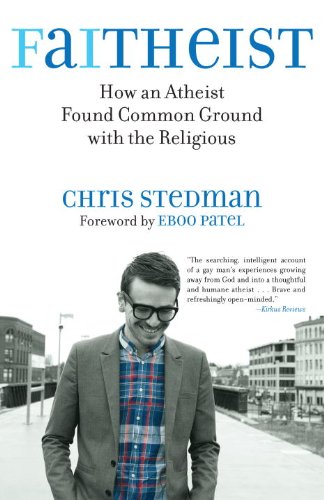Book review: Faitheist
by Chris Stedman
★★★★★
Oh, man, do I relate. Here is an atheist who wants to lift atheism above the polarized wars that have developed from writings of the New Atheists. While I’ve never considered myself an atheist (I’m happy with the phrase “agnostic Christian”), even if I were, I would hesitate to take the title. I don’t want to be known as someone who tears down rather than builds up. I have more in common with nonbelievers than fundamentalists, but I have never been able to swim in the waters of an online atheist forum without feeling queasy … like I just plain don’t belong. I’m not alone: so uncomfortable are many people with atheists that polls show them to be the least electable group in America.
Why? Why are atheists so distrusted? Enter Chris Stedman, a believer-turned-atheist who misses the goodness of Christianity, and feels happiest when he is joining the Church in the soup kitchen.
Yet, the “regular Joe” atheist is as misunderstood as anyone of any contrary belief system, insists Stedman. The problem is, when there is little familiarity, extremists become the face of a religious movement, and this is just as true of non-religion (atheism). The New Atheists have managed to monopolize the public discourse on atheism. They have succeeded in making atheism more publicly known, but at what cost?
The goal of the New Atheist movement is the total eradication of religion. Confront the religious, expose the idiocy of believing, and sneer it under the table. The antireligious rhetoric spewed by aggressive atheists is not a critique of theology, says Stedman. That, he could deal with on an intellectual level. Rather, such attacks are “based in a willful ignorance of what it actually means to be religious and of the way religious lives are lived, and turn religious people into a cheaply mocked caricature.” Chris tells of trying to fit in at an American Atheists gathering in New Jersey, which was “packed full of blasphemy sessions and speeches comparing religion to sexually transmitted diseases.” He recalls how “Witnessing the sheer vitriol some expressed toward the religious, I actually cried—hot, angry tears. I called friends of mine back home—atheists, no less—and recalled what I’d seen … One friend said to me: ‘You see, this is why I don’t want to call myself an atheist.’”
Today, says Stedman, he cannot recount the number of fellow atheists and agnostics who do not want to be associated with the movement. What has gone wrong? How did atheism sink to the level of polarized fundamentalism it claims to despise, and can the image be fixed?
Chris is trying. He suggests that the atheist movement should be more about what it does stand for than what it doesn’t. Energy spent disparaging what others believe (the New Atheism) is worse than wasteful; it’s toxic. There is no benefit in dehumanizing those with different metaphysical beliefs. Far more effective would be for atheists to promote constructive dialogue with the religious, treating them as intellectual equals. Atheism’s reputation can be rescued by reaching out, attempting to understand and empathize rather than bulldoze and mock. So, Stedman decided to walk the walk. He became the Assistant Humanist Chaplain at Harvard University, working in interfaith relations.
An atheist chaplain! Hee, hee! I doubt the New Atheists are amused, but I am in awe. This is a captivating, inspiring, must-read book, whether you are a believer or an atheist. Get it now.












 354 Circles
354 Circles
 603 Goodreads Friends & Fans
603 Goodreads Friends & Fans

 Hello! I'm an author, historical Jesus scholar, book reviewer, and liberal Christian, which means I appreciate and attempt to exercise the humanitarian teachings of Jesus without getting hung up on any particular supernatural or religious beliefs.
The Bible is a magnificent book that has inspired and spiritually fed generations for thousands of years, and each new century seems to bring a deeper understanding of life’s purpose. This is true of not only Christianity; through the years, our age-old religions are slowly transforming from superstitious rituals into humanitarian philosophies. In short, we are growing up, and I am thrilled to be riding the wave.
I avidly read all thought-provoking religion titles. New authors: I'd love to read and review your book!
Hello! I'm an author, historical Jesus scholar, book reviewer, and liberal Christian, which means I appreciate and attempt to exercise the humanitarian teachings of Jesus without getting hung up on any particular supernatural or religious beliefs.
The Bible is a magnificent book that has inspired and spiritually fed generations for thousands of years, and each new century seems to bring a deeper understanding of life’s purpose. This is true of not only Christianity; through the years, our age-old religions are slowly transforming from superstitious rituals into humanitarian philosophies. In short, we are growing up, and I am thrilled to be riding the wave.
I avidly read all thought-provoking religion titles. New authors: I'd love to read and review your book!
 Hi! While Lee writes the articles and reviews the books, I edit, organize, and maintain the blog. The views expressed here are Lee's but I'm his biggest supporter! :-)
Hi! While Lee writes the articles and reviews the books, I edit, organize, and maintain the blog. The views expressed here are Lee's but I'm his biggest supporter! :-)
Connect With Me!